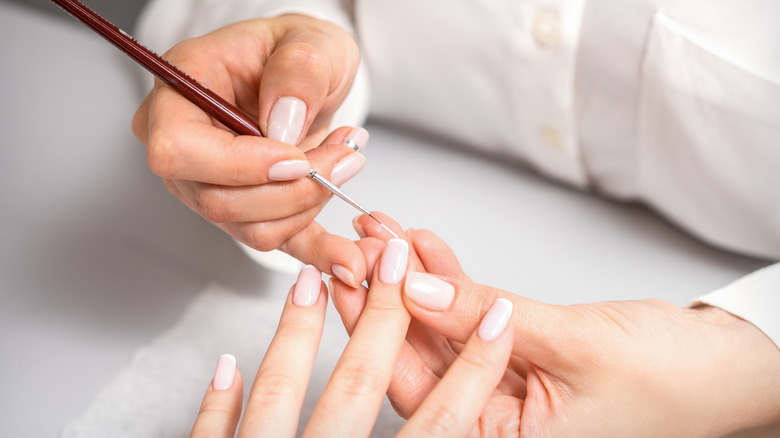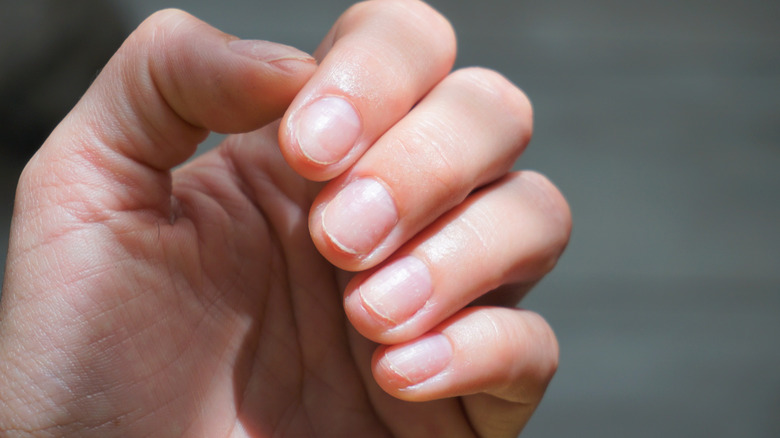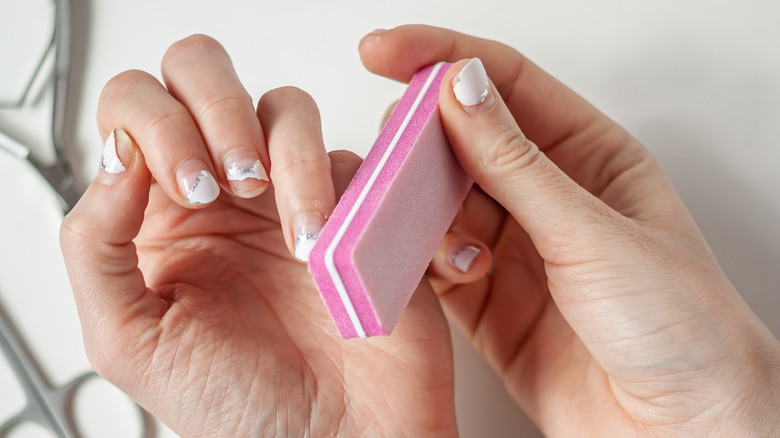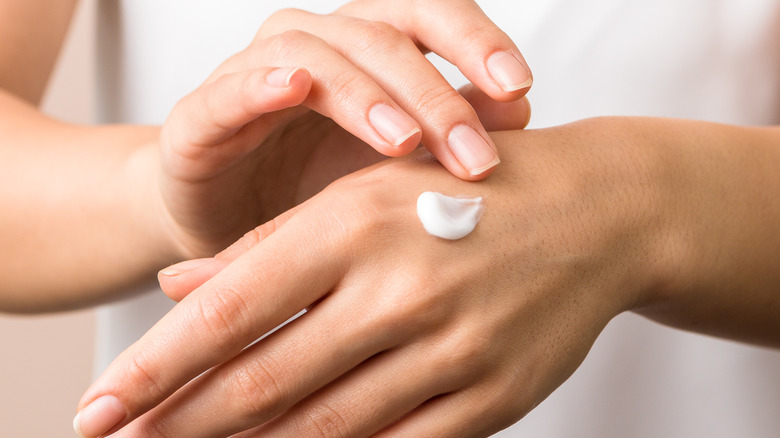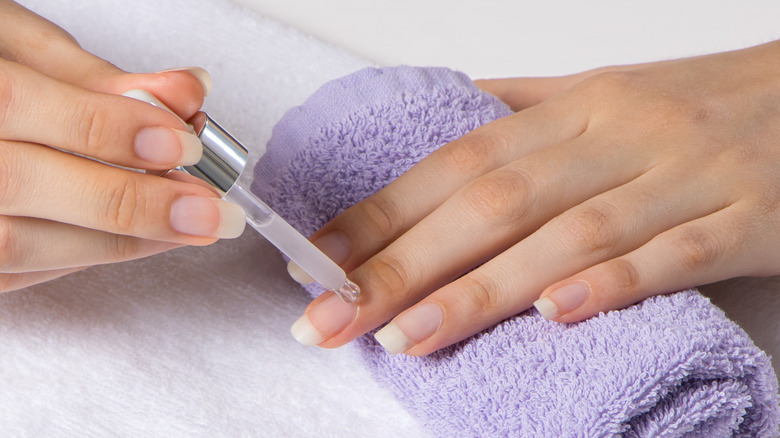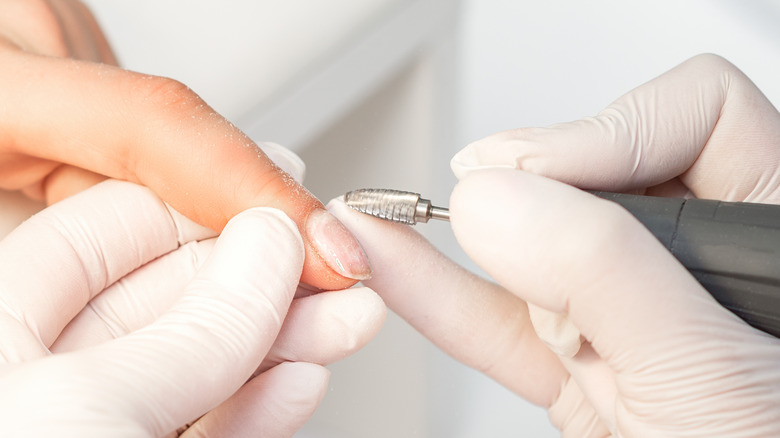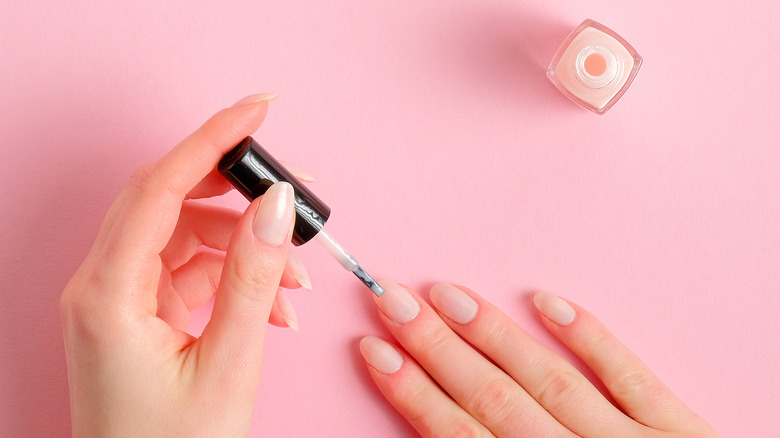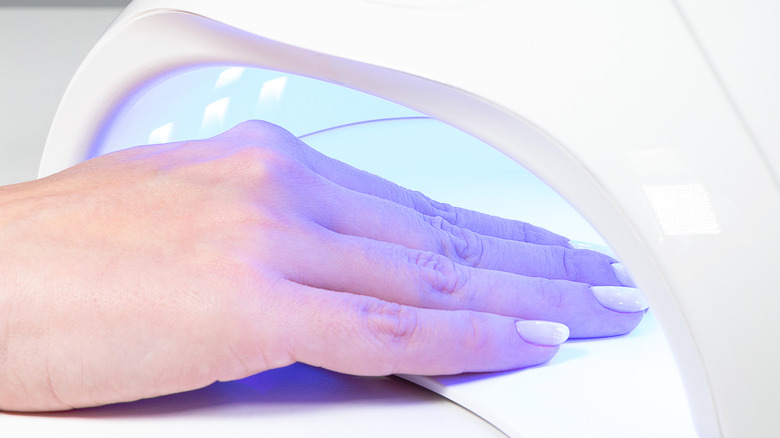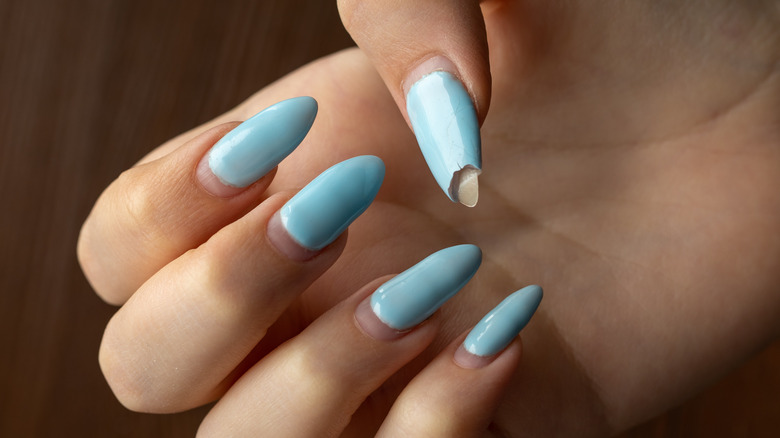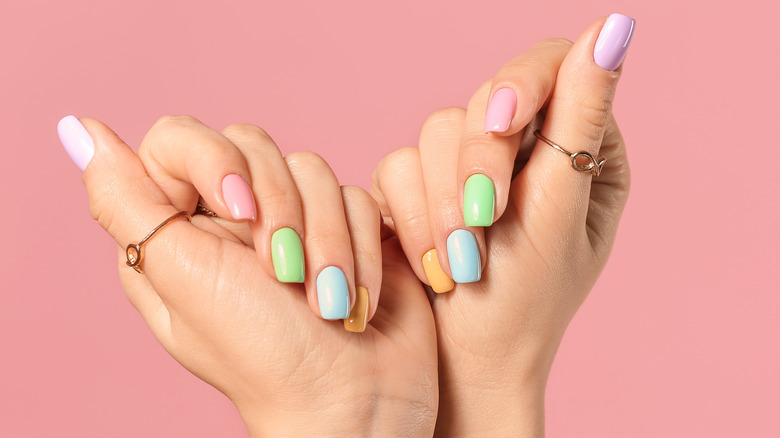The Biggest Mistakes Everyone Makes With Gel Nails
We may receive a commission on purchases made from links.
Anyone who's switched from regular to gel polish can attest to how much of a game-changer it is. One of the biggest pros of gel is that it's pretty fuss-free. Getting it done and removed takes longer than the usual nail appointment, but it's worth it. The beauty of it is that once the salon appointment is over, you don't really have to give your nails much of a second thought.
A lot of the issues with regular nail polish become a thing of the past once you opt for a gel manicure. Due to the quick drying time, you don't need to worry about bumping into anything accidentally and ruining your nails. Instead, you can fumble around for your keys in your bag and still have a fresh manicure. Plus, if you get a manicure you really like, whether it's your favorite nail polish or the latest nail art trend, you won't have to part with it right away, since gel polish allows for glossy, chip-free nails for around two to three weeks.
The pros list goes on and on: long-lasting manicures, minimal drying time, and easy maintenance. As popular and convenient as they are, there are still a lot of big mistakes people make that can be easily avoided.
Not giving your nails a break
People with naturally brittle or sensitive nails should be extra mindful of this rule. As tempting as it may be to keep those gel nails on rotation for months on end, you may want to reconsider, especially if you start to see signs of damage. However, if you get your gel nails done back-to-back, Dr. Chris Adigun warns, it'll be difficult to properly gauge the health of your nails. In more serious cases, this could include infections and tumors (via Teen Vogue).
Nail artist and salon owner Brittney Boyce recommends giving your nails a gel-free break for around three to four weeks if your nails have become significantly weaker (via Allure). But if your nails are in a pretty dire state, then three to four weeks may not be enough. Instead, give your nails at least a six-month break to allow them to grow, with your nail appointments better spent on simple grooming (via Allure).
There isn't a hard and fast rule for how often to get your gel manicure done, but other dermatologists recommend reserving gel nail appointments for when you really need them (via the American Academy of Dermatology Association).
Incorrect gel nail removal
More often than not, the damage that comes from gel manicures isn't from the product itself, but from the way it is applied and removed. Though it is admittedly more taxing to remove than regular polish, it shouldn't be painful, but some salons aren't as mindful. "[Some] don't take the necessary time that is needed to remove gel and acrylic in a way that doesn't damage the nail plate," manicurist Mazz Hanna explained (via Allure). So if you find that your nail technician is rough with your nails during removal, ask them to give your nails another soak in acetone and opt for an orange wood stick to gently push the polish off (via Allure). "No one should be scraping your nail bed aggressively. The product should just crumble off," celebrity nail artist Miss Pop told Seventeen.
Before removal, your nails should be soaked for around 10 minutes, and not any longer as it can cause drying (via Refinery29). "Acetone is extremely dehydrating. When the skin isn't protected, or when soaking too long, this can cause the skin to become dry and nails to brittle," Tracylee Percival, celebrity manicurist, explained to The Zoe Report.
If you've ever noticed white spots on your nails and wondered what caused them, they're often due to mishandling during salon visits, which also include incorrect gel nail removal (via Refinery29). According to dermatologist Lamees Hamdan, M.D., those spots aren't necessarily a cause for concern, but they often point toward a nail bed injury.
Not moisturizing enough
Moisturizing is key to your skincare, and your nails are no exception. It's something worth incorporating into your skincare routine if you haven't already. "Moisturizing our nails on a daily basis can definitely help strengthen nails. I always suggest massaging upwards from the cuticle in a very gentle fashion," dermatologist Shereene Idriss shared with Allure.
Hydrating your nails and the skin surrounding them should be consistent before, during, and after every manicure or pedicure. Not only does it help your nails look better, but it can also help prevent chipping and breakage. It's advisable to have hand cream with you wherever you go. Luckily, many hand cream options on the market do the job and are cost-effective too.
According to Dr. Karan Lal, a board-certified dermatologist, "[Hand skin] requires more oils and lipids to restore moisture" (via The Strategist). When choosing a hand cream, it's best to go with something more heavy-duty like an ointment or a balm, while steering away from those with high water content (via Culture and Cream).
Get the most out of your hand cream by trying out a trick from dermatologist Dr. Melanie Palm. She shared, "Do a cream at night to keep hands moisturized, putting cotton gloves over it to enhance penetration" (via Self). It's a small addition to your nightly skincare routine that'll go a long way.
Lack of cuticle care
Cutting the cuticle and digging under the nail bed are two big nail care no-nos; doing so can likely lead to an infection. The American Academy of Dermatology Association advises against tampering heavily with the cuticles: "Never cut or forcefully push back your cuticles. If you must push them back, only do so gently after a shower or bath."
Cuticles are integral to nail health, as infections are likely to occur with damaged and dry ones, per Orly. Cuticle oils and hand creams are important products to have in your nail care rotation. Cuticle oils in particular are great for overall nail health as they hydrate and repair the nail simultaneously. Luckily, there are many good options on the market to choose from. Orly's argan cuticle oil drops are a hit with 98% customer satisfaction. A user claimed that it gave "noticeable results with one application." Another option is CND SolarOil, an award-winning product that's highly recommended by its users, who claimed that it improved their overall nail health and helped with nail growth.
Incorrect nail preparation
It's important to find a nail salon that you can trust, regardless of how frequent your visits are. Along with having trained technicians, it's best to find a salon that keeps its stations and tools sterilized, according to the American Academy of Dermatology.
Proper nail preparation is the key to getting the most out of your gel nails. For better adhesion, the nails should be cleaned to remove any oils or dirt before attempting to apply any product (via PN Selfcare). Aside from making your manicure last longer, it helps with removal later on. The bottom line is that gel nails aren't supposed to be hard to remove. Excessive force is unnecessary when it's done correctly. According to Dr. Chris Adigun, "Properly cured gels remove easily with the acetone soak, whereas improperly cured gels require tools to manually remove them" (via Teen Vogue).
Not being mindful of ingredients
Though they may not seem like it, nails are actually extremely absorbent. With all this product absorption, it's worth taking a second look at the ingredient list during those salon visits. According to Dr. Loretta Davis of Augusta University Health, "Nails are really porous, about 1,000 times more permeable to water than neighboring skin." While many companies have made the effort to omit harmful ingredients from their formulas, there are still some that have slipped through the cracks. Also, many of them can get away with false advertising and the loose guidelines for what counts as "non-toxic" in the industry (via Into The Gloss).
According to celebrity manicurist Jenna Hipp, people should steer away from gel polishes that contain formaldehyde, toluene, and dibutyl phthalate (DBP), carcinogens she dubs the "toxic trio" (via Teen Vogue). The effects of these ingredients differ and can range from mild to severe. For some, they may only cause skin irritation, but in the long run, these ingredients have been linked to a variety of more serious health issues (via Orly).
Not protecting your hands from the UV or LED lamps
There are differing opinions on the safety of LED and UV lamps used in gel manicures. Though some experts say that the effects are nothing to worry about, there is still a very minimal risk of skin cancer or premature aging (via the American Academy of Dermatology Association). You might want to skip gel nails completely if your skin reacts badly to exposure, especially if it could be linked to any pre-existing medical conditions or treatment you are undergoing, per Greatist. It might be better for you to use nail stickers, which are inexpensive and efficient, or just get a regular manicure.
If you prefer to err on the side of caution, then you should consider applying sunscreen or investing in gloves for your nail appointments. Dr. Heather Stevie Summe explained to Buzzfeed, "While the risk is probably negligible, it isn't a bad idea to apply SPF 30 or above before the exposure — or invest in some fingerless UPF gloves."
Picking at your gel nails
In some cases, especially when not applied correctly, gel polish can start to lift, and it can become very tempting to pick at it and remove it. Experts unanimously advise against doing so, regardless of the urge, and to schedule a gel removal appointment instead.
Though it looks and feels completely harmless, picking at the polish is damaging to your nails. "Every time you peel the gel off without breaking the bond, then a layer (or more) of your nail plate is removed," dermatologist Melanie Palm, M.D., cautioned (via Self). Picking at the nails strips it and weakens it in the long run.
To better illustrate, Natalia Mihailova shared an example with Refinery29: "Imagine removing your makeup and taking off the top layer of your skin with it, or scratching off your makeup — that is exactly what happens to the nails if you peel them off yourself. You're taking a layer off with the Shellac." When put in those terms, anyone would think twice before picking at their nails.
Keeping your gel manicure on for more than two to three weeks
As enticing as it may be to just leave your nails on for longer than the recommended two to three weeks, it's best to schedule that gel nail removal. After all, the most desirable nails are healthy ones. Evelyn Lim, an editorial nail artist and nail educator, explained the effect of having regular or gel polish without any breaks. She shared, "If you have something on your nail, it restricts moisture, creating somewhat of a barrier so your nails can harden" (via Cosmopolitan).
Regardless of how good your gel manicure looks, leaving it on for too long increases the chances of damaging your nails. A big no-no is to keep your gel manicure on when the nail has been damaged, chipped, or lifted, per Greatist. Lifted gel nails should prompt a visit to the nail salon ASAP, since it is possible for moisture to get trapped under the gel. This could be a breeding ground for bacteria or fungi (via Self). If that doesn't have you running to the nail salon for a gel removal, we don't know what will.
